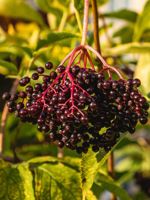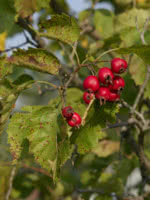Mon-Fri 9am - 5pm Mountain time
Round Leaf Hawthorn vs Bob Gordon Elderberry
Sambucus canadensis Bob Gordon
Crataegus chrysocarpa (Crataegus rotundifolia)
Bob Gordon Elderberry is a Black Elderberry cultivar that produces berries that are larger and sweeter than other varieties, making it one of the top cultivars. It produces large clusters of white flowers that turn into large clusters of dark purple to black berries. The berries are well-suited for baked goods, jams, jellies, and syrups. It was selected from the wild in Missouri.
The large berry clusters that the Bob Gordon Elderberry produces will often end up hanging downward. This makes it more difficult for birds to feed on the berries. If birds are a concern, this might be the right berry for you.
Black Elderberries are considered to be partially self-pollinating. So while they will still produce some berries without cross-pollination, planting with another variety will increase yields. Consider planting with Black Elderberry or Ranch Elderberry.
Warning: the seeds, stems, leaves, roots, and uncooked berries are toxic to humans when eaten in quantity. Berries should be cooked to make them safe for human consumption.
Getting its name from rounded, toothed leaves, the Round Leaf Hawthorn is a winter hardy shrub that grows small, red, berry-like fruits.
Commonly used for landscaping, this shrub can also be found along stream banks and in wooded areas. Caution is advised when handling the Round Leaf Hawthorn, as it can have sharp thorns approximately 1" long.
Bob Gordon Elderberry Quick Facts
Round Leaf Hawthorn Quick Facts
Toxicity: leaves, stems, and uncooked berries are poisonous to humans

